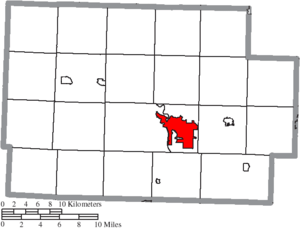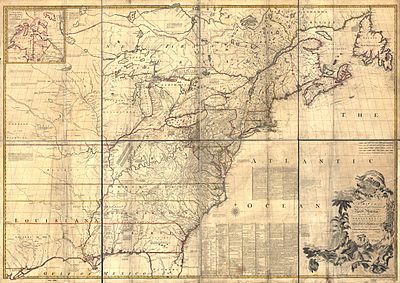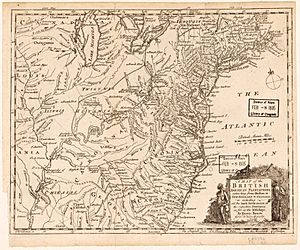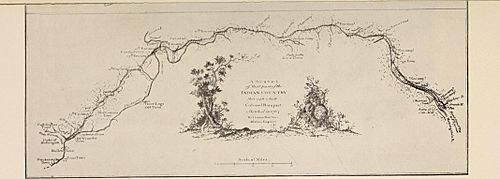Muskingum (village) facts for kids
Quick facts for kids
Muskingum or Conchake
Msh-Kik-Wam or Cong-Sha-Keh
|
|
|---|---|
|
Historic Native American village
|
|
| Etymology: Unami: msh-kik-wam "swampy ground" or Iroquoian languages: koshaxkink "river crossing" | |

Location of Muskingum Village in Coshocton County, Ohio
|
|

Former location of Muskingum, present-day site of Coshocton, Ohio
|
|
| State | Ohio |
| Present-day Community | Coshocton, Ohio |
| Founded | 1748 |
| Abandoned | 1759 |
| Population | |
| • Estimate
(1750)
|
300-400 |
Muskingum (also called Conchake) was a Wyandot village in southeastern Ohio. It existed from about 1747 to 1755. This village was a very important place for trading goods in the early 1750s.
However, a terrible smallpox outbreak hit the town in the winter of 1752. This disease caused many people to die. The town was briefly repopulated after the outbreak. But then, a new community was started a few miles east by a leader named Netawatwees. The modern city of Coshocton, Ohio was founded near the old village site in 1802.
Contents
What's in a Name?
The name Muskingum might come from the Shawnee word mshkikwam. This word means 'swampy ground'. Another idea is that it comes from the Lenape language. It might refer to thorns or a type of thorn bush.
Some people also thought Muskingum meant 'elk's eye'. This idea comes from combining mus (elk) and wəshkinkw (its eye). A missionary named David Zeisberger wrote that the Muskingum River was called Elk's Eye. He said this was because many elk used to feed along its banks.
John McCullough was a captive who lived in Muskingum for a short time in 1763. He said the name "Moosh-king-oong" meant 'clear eyes'. He explained this was because the river had many fish with very clear eyes.
The name Conchake (Cong-sha-keh) is another name for the town. It is still seen in the name of Coshocton, Ohio. This name comes from the Lenape word Koshaxkink, which means 'where there is a river crossing'. It can also mean a place or path of safety. The Wyandot people gave this name in 1748. They moved to the Muskingum River area to escape fighting with the French.
Starting the Village in 1748
Wyandot people built Muskingum in the spring of 1748. They arrived with a leader named Nicholas Orontony. In April 1748, Orontony and 119 Wyandot warriors, along with Miami warriors, attacked a French fort. This fort was called Fort St. Philippe.
After the attack, Orontony left his old village, Junundat. He and his people moved to the Ohio valley. About 70 warriors and their families settled at Muskingum. The rest went further east to build a new town called Kuskusky.
Christopher Gist's Visit in 1750
An explorer named Christopher Gist visited Muskingum on December 14, 1750. He wrote about his visit in his journal. He noted that the town of Muskingum had about 100 families.
When Gist arrived, he saw English flags flying. He learned that the French had recently captured some English traders. A trader named George Croghan had told all white men to come to Muskingum for safety. The Native Americans had also called their people to a council meeting.
Gist learned that two of Croghan's men were captured by the French. Their horses and animal skins were also taken. On Christmas, Gist read from the Bible to some of the Native Americans. They thanked him and invited him to live in Muskingum permanently. They even gave him a Wyandot name, Annosanah, which meant "a very Good man."
Gist worried about being captured by the French. The Native Americans then invited him to "bring great Guns and make a Fort" at Muskingum. They also wanted him to baptize their children and perform Christian weddings. Gist told them they would need a minister for that. It is thought that the Native Americans were more interested in having an English fort with cannons. This was because attacks by French-allied Native Americans were happening more often.
The next day, Gist saw a prisoner being punished. Barney Curran, a trader, asked to bury the body.
On December 9, two more traders arrived. They brought news that another English trader was captured by the French. They also said that three French soldiers had left their side and joined the English. The Native Americans wanted to punish the French soldiers. But the English traders would not let them. Instead, the French soldiers were sent to George Croghan in Muskingum.
Trading with the English

Before 1750, George Croghan set up a trading house in Muskingum. It had a home and a storage building called "the King's House." Croghan was there when Christopher Gist visited in December 1750.
The French took control of this trading house in 1753 or 1754. They took all the goods stored there. Records from 1756 show that Croghan lost his storehouse at Muskingum, valued at £150.
In 1752, William Trent visited Muskingum on his way to Pickawillany. He wrote in his journal on June 29, 1752: "We got to Muskingum... where we met some white men... who told us the town was taken and all the white men killed." Trent was talking about Pickawillany. French-allied Native Americans had burned that town on June 21, 1752.
The Village Becomes Empty in 1755
Smallpox was a very bad disease that spread through many communities in the Ohio Country from 1752 to 1753. By the time Gaspard-Joseph Chaussegros de Léry visited "Conchake" on March 29, 1755, the village was almost empty.
He wrote that Muskingum was a place where the Wyandots had found safety during a war. He said 120 of them died in one summer. He could still see graves and signs of the old village. At that time, only two cabins were left. One was used by a Christian Native American from Kahnawake. The other belonged to the Five Nations.
A captive named Charles Stuart passed through the area on November 23, 1755. He saw Croghan's home and trading house still standing. In his story, he wrote that he saw "the House where an Eng[lish] Indian Trader had Formerly Lived and where was an Indian House of Both which were deserted."
Some Lenape people, including Shingas and his brother Pisquetomen, moved to Muskingum. This was after their village, Kittanning, was destroyed in 1756. By 1758, they had moved to Kuskusky.
Captives in Muskingum
By 1758, people had moved back to Muskingum. It became home to several English captives. These captives were taken during raids on frontier communities in the French and Indian War.
- Marie Le Roy and Barbara Leininger: These two girls, both 12, were captured during the Penn's Creek massacre in October 1755. They were taken to different villages. After their village of Kittanning was destroyed, they were taken to Muskingum. They escaped in March 1759 with Hugh Gibson.
- Hugh Gibson: Hugh, 15, was captured in July 1756 by Lenape Native Americans. His mother and a neighbor were killed. He was taken to Kittanning and adopted by a Lenape war chief. After Kittanning was attacked, he was taken to Muskingum. In April 1759, he escaped with Marie Le Roy and Barbara Leininger. They walked 250 miles to Fort Pitt.
- John McCullough: John was 8 years old when he was captured by Lenape warriors in July 1756. He lived with a Lenape family for two and a half years. In 1763, McCullough was taken to "Moosh-king-oong" (Muskingum). He said this name meant 'clear eyes' because of the fish in the river. In December 1764, McCullough was set free. He was one of over 200 captives released by order of Colonel Henry Bouquet.
Later History of the Area
On March 15, 1764, Colonel Henry Bouquet's army camped at the empty site of Muskingum. They were there to receive captives from Native Americans. This was part of a peace agreement signed the previous October. The Native Americans handed over about 260 captives.
A new village was started a few miles east of Muskingum in the 1760s. It was founded by Netawatwees (also known as Newcomer). He moved to the area with his group of Lenape Native Americans. The Lenape name for this new town was "Gekelukpechink," meaning "still water."
This town became an important meeting place. English and American traders called it Newcomer's town. Later, it became Newcomerstown, Ohio. By 1771, more than one hundred homes had been built. The town was the main center for the Lenape people.
A preacher named David McClure visited the town in September 1772. He described it in detail: "This town is called New Comers town by the English. It stands on the West bank of the Muskingum. It has about 60 houses, some made of logs, and others of tree bark. There are nearly 100 families. It is the main town of the Delaware nation, and where the king and most of the Councillors live. There are several small villages up and down the river. This place is about 60 Miles above the mouth of the Muskingum. Eight or ten acres around the town are cleared. On the other side of the River is a large corn field, in rich low ground. It is fenced together, and each family has its own part to plant. Some of the houses are well built, with cut logs, stone chimneys, and rooms. I was told these were built by English captives during the French wars.
The king, whose name is Nettautwaleman, welcomed me. He is an old man, tall and active. His house is the largest, built of small square logs. Around the walls, for beds and seats, were planks raised from the ground. They were covered with buffalo and bear hides. On Tuesday afternoon, a messenger led me to the Council House. It was a long building covered with hemlock bark, with a door at each end. The Conjuror's house was the best built in town except the king's. It had a cellar with stone walls, a staircase, a good stone chimney, and closets. This made it look like an English home. Between the house and the river bank was a healthy peach orchard. The Muskingum is a beautiful country. The soil is rich and deep. The land rises slowly from the river and forms large meadows and plains. Some places are covered with thick grass, with no trees or bushes for miles."
In 1776, over seven hundred Lenape people and several traders lived in Newcomerstown. Gekelukpechink was destroyed on April 20, 1781. This happened during Brodhead's Coshocton expedition. It was in response to Lenape raids against settlers.
The town of Tuscarawas was started by American colonists in 1802. It was named after the river. The town was renamed Coshocton in 1811. This happened when it was made the county seat by the government.



